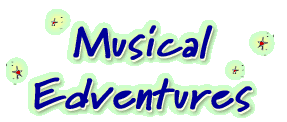Gallery
I wanted a place to post some of my favorite things that I’ve done over the years. Hence this page.
Dark Majesty
Dark Majesty was the first of my concert band compositions, and I’m very proud of it, musically and commercially. It won a J.W. Pepper Editor’s Choice award and outsold by a factor of three anything else my publisher had ever published. It is a very easy piece that doesn’t sound easy—just exactly what I was going for. All instruments with the exception of percussion have no notes faster than a quarter note, and the instruments’ ranges are all very narrow. It’s in Phrygian mode, and sounds BIG.
Dark Majesty
Spiders in Webs
A four-year-old boy improvised this delightful ditty, and I was fortunate enough to have the tape running. Here is his original version (45 seconds), and what I did with it (1 minute). I chose to treat the pitches this child sang as accurate and intentional, rather than out-of-tune diatonicism; transcribing, harmonizing, and orchestrating them as such. This led me down harmonic paths I would probably not arrived at, left to my own devices.
I played recorders, several clarinets, bass clarinet, guitar, mandolin, bounced-pencil mandolin, tenor banjo, five saxes of various sizes, bones, and bodhran. I added a cwazy synthesized Mac voice, and a bit of my own voice. A friend played march-style snare and brushes.
I had a barrel of fun making this, and I still love hearing it. I hope you will too.
Spiders in Webs (original improv)
Spiders in Webs (extrapolated version)
FableVision Animation Demo
FableVision is the media company run by my old friends and collaborators Peter (my illustrator) & Paul Reynolds. Here is their original 1997 animation demo video for which I composed, played, and recorded the music. Making this was hard work and great fun. The original audio and video masters are both lost forever, so this was taken from an authentic historical VHS tape. You can tell it’s truly authentic from the TRACKING notice at the beginning, as well as the ummm, less than optimal video quality.
Behind-the-scenes notes: No synthesizers whatsoever were used, and no living organisms were harmed in the making of this video. If I remember correctly, I played over 40 dagzillion instruments on the soundtrack. Among them were piano, guitars, tenor banjo, mandolin, tenor mandolin, bass, recorders, clarinet, bass clarinet, saxes, erh-hu (Chinese violin), a folk harp, musical saw, various drums and bones, slinkies, scrub brush, a huge dictionary (!), zoob tube, shakers, a broken mandolin with a broken neck, an authentic historical Marxochime, and many more miscellaneous instruments and found objects.
Compositionally, I had an important choice to make when writing the music for the demo—whether to ignore the many many video edits, and just write music that went on its merry way, taking no notice of the visuals, or to write “with” the edits. You’ll hear which decision I made.
Keys for Alison
My friend and highly accomplished classical pianist Alison asked me to write her something. So I wrote her Keys for Alison, an ostinato-laden intro and poly-tonal twelve-bar blues. See if you can hear the blues form amidst all the many strange notes.
Keys for Alison
MacWorld Music
I’m including my MacWorld Music here not as an example of fantastic composition, but rather, for fun and historical (in)significance. In 1987, I had the honor of demoing my friend and musical partner-in-crime Greg Jalbert’s fledgling Mac MIDI sequencer Portrait at the MacWorld show in San Francisco. Portrait was way ahead of its time, with features that wouldn’t be adopted by other sequencers (now called DAWs) for years. It was so utterly right-brained in its construction that I could compose with it as an ally, rather than its getting in my way. Using Portrait, I stream-of-consciouness-ed MacWord Music ultra-fast-ly, with fellow music geeks looking on, to demonstrate the wonders and hitherto-unimagined abilities of this visionary—and ultimately ill-fated—app, which sadly never saw the commercial light of day due to the company’s tragically dissolving.
The sounds are from relatively inexpensive synths of the time: Ensoniq ESQ-1, Yamaha FB-01 & TX-81Z, a Roland Sound Canvas, or maybe even an MT-32, and I don’t know what else, if anything.
I wish you could’ve been there to see and hear the process of my working—and playing—with this amazing, right-brained, right-hand-pen Mac sequencer. But since you weren’t (or were you?), may you enjoy the zaniness.
MacWorld Music

